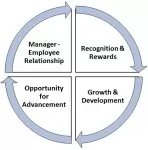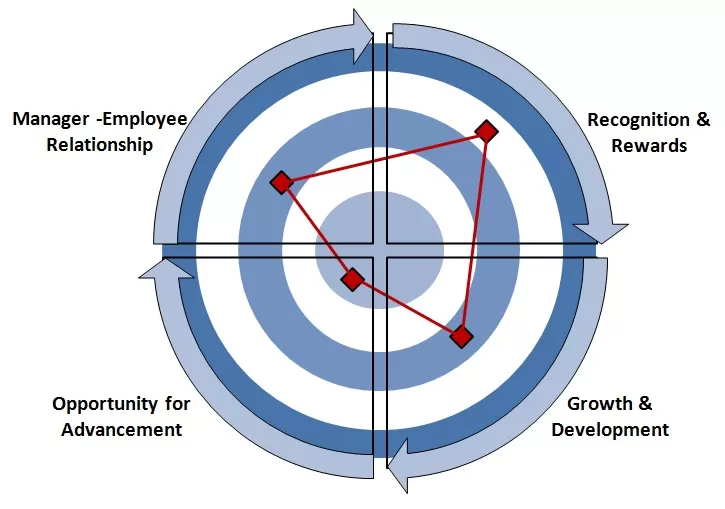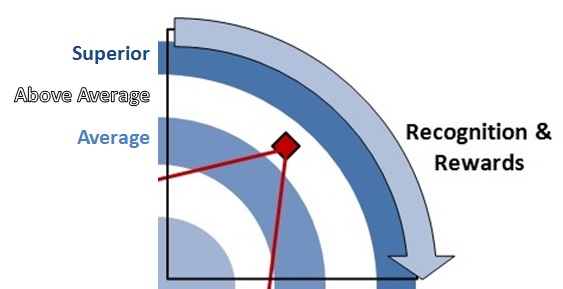 This is the third of five posts on The Wheel of Employee Engagement. In The Wheel of Employee Engagement: An Introduction, we discussed how to create your own Wheel of Employee. In the previous post, The Wheel of Employee Engagement: Manager – Employee Relationship, we began looking at each of the identified areas of disengagement and explored some suggestions for improving our previous rating. Remember, our goal is to align all areas along the same rating beginning with “Average.”
This is the third of five posts on The Wheel of Employee Engagement. In The Wheel of Employee Engagement: An Introduction, we discussed how to create your own Wheel of Employee. In the previous post, The Wheel of Employee Engagement: Manager – Employee Relationship, we began looking at each of the identified areas of disengagement and explored some suggestions for improving our previous rating. Remember, our goal is to align all areas along the same rating beginning with “Average.”
Using our example Wheel of Employee Engagement, the second area of disengagement we will review is “Recognition & Rewards.”
In our example, we rated ourselves as “Above Average” in the Recognition & Rewards area. Since this area is already above our baseline, we would want to start by identifying another area where we rated ourselves as “No Focus,” “Below Average,” or “Average” before considering how we can move into the “Superior” category.
Regardless of where you rated yourself, let’s consider some suggestions to attain each of the ratings.
Average
- Recognize that you get what you reward.
- Know that recognition and rewards need to be timely, specific, and meaningful.
- Seek out individuals and teams to say “Good Job.”
- Say “Thank you” in person and in front of others (when appropriate).
- Provide pizza or some other treat to show appreciation.
- Celebrate employee birthdays, company anniversaries, and promotions.
Above Average
- Sincere in giving recognition and rewards.
- Realize that rewards do not have to be expensive or monetary.
- Utilize the Company’s formal recognition and rewards program.
- Recognize the value of each employee: trust and autonomy.
- Focus on what employees want in terms of recognition and rewards.
- Realize that recognition and rewards are not a one size fits all approach.
- Allow flexibility of work hours, lunch time, or time off as a reward.
- Look for opportunities within the department or area to recognize the team or individuals whenever possible, i.e. team meetings, newsletters, etc.
Superior
Note: While it may be possible to attain this level, there will be times when further work will be needed, i.e., new employees, reorganizations, business challenges, etc. Recognition and rewards is an ongoing process.
- Lead by example to create a culture of recognition and rewards.
- Encourage employee to employee recognition and rewards.
- Dedicate time each day writing individualized notes of thanks and appreciation to those that have made a difference.
- Recognize the value of each employee: ask opinions and involve in decision making.
- Create meaningful awards, i.e., the Boot Award given to those who “Kick Butt.”
- Look for opportunities outside of the department or area to recognize the team or individuals whenever possible.
NOTE: The items listed above are meant to provide you with a starting point as you consider ways to improve your category ratings. They are not meant to be comprehensive.
In the next post, we’ll look at ways to improve the third area of disengagement: Growth & Development. Until then, revisit some previous posts to learn more about recognition and rewards.
- Giving Thanks
- Cyber Monday
- Black Friday
- Friday The 13th
- Proactively Manage Your Career with a Simple List
- Just Say Hello!
- Give Employees Their “DOSE” of Chemical Injections to Influence Engagement!
What are your thoughts on these suggestions? What would you include/exclude from each rating?
Let’s Engage!
I’m Agent in Engagement Simpson…Gregory F Simpson.
I’m excited about this opportunity to connect with fellow “Agents.” Subscribe to the RSS Feed to receive the latest updates and/or register to comment on posts.
 You can follow me @agtinengagement.
You can follow me @agtinengagement.
Email me at g…@a…t.com.
Learn more about me at www.gregoryfsimpson.com.
P.S. First time here? Welcome to the Agent In Engagement site. Thanks for taking the time to stop by! I hope you’ll explore the rest of the site. Let me know what employee engagement topics interest you.
Other recent Agent in Engagement articles by Gregory F Simpson:
- Employee Engagement Briefing for Week of February 9 – 13, 2015
- Employee Engagement Quotes from February 2 – 6, 2015
- The Wheel of Employee Engagement: Manager – Employee Relationship
- The Wheel of Employee Engagement: An Introduction
- Continuing to Engage Through The Infographic
- Top Employee Engagement Infographics of 2014

